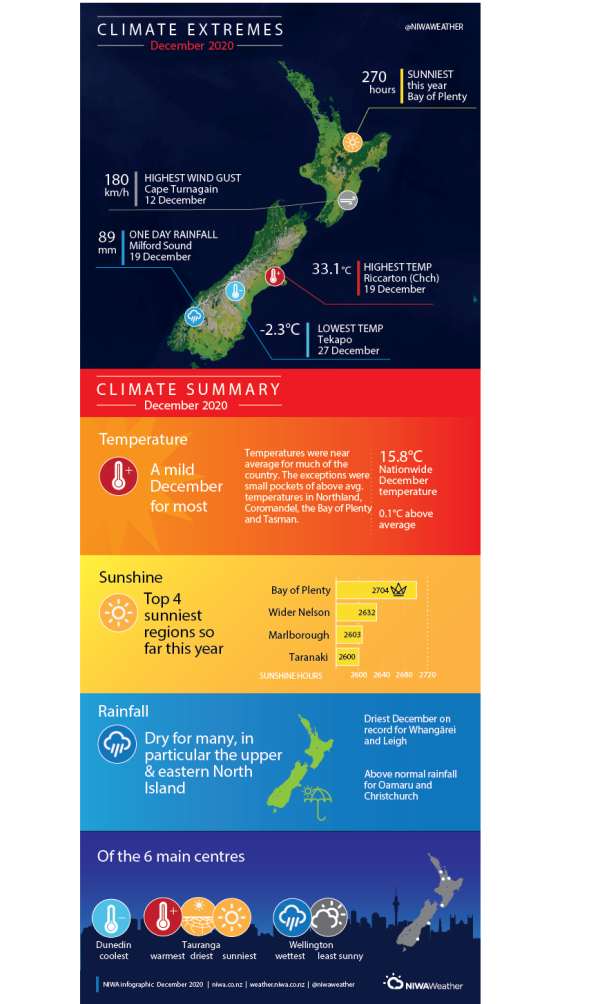A dry and mild end to the year
|
Rainfall |
A dry month for much of the country. Well below normal rainfall (<50% of normal) was experienced in much of the upper and eastern North Island while coastal Taranaki and Manawatu-Whanganui saw near normal (80-119% of normal) or above normal (120-149% of normal) rainfall. In the South Island, rainfall was largely well below or below normal (50-79% of normal), with the exception of a few locations in coastal Canterbury and Stewart Island that saw above normal rainfall. |
|
Temperature |
Temperatures were near average (±0.50°C of average) for much if the country. The exceptions were small pockets of above average temperatures (>1.20°C above average) in Northland, Coromandel, the Bay of Plenty and Tasman. |
|
Soil Moisture |
At the end of the month, soil moisture levels were lower than normal for the upper North Island and higher than normal for coastal areas from Taranaki through to Wellington, for the Nelson-Tasman region and for northern Otago. Soil moisture levels were near normal elsewhere. |
Overview
December 2020 was characterised by settled and dry weather with mild temperatures. Mean sea level pressure was higher than normal in the Tasman Sea and extended over the country frequently. This resulted in more westerly to southwesterly winds than normal, keeping temperatures near average despite plentiful sunshine. Moderate La Niña conditions continued in the tropical Pacific.
The majority of Aotearoa experienced a drier than normal month with dryness most pronounced in the upper and eastern North Island, atypical for La Niña, where rainfall totals were well below normal rainfall (<50% of normal). Several locations observed one of their driest Decembers on record, record driest in the case of Whangārei, where just 6 mm of rain fell (records extend back to 1937). The dry weather resulted in locations such as the Far North and Tauranga introducing water restrictions near the end of the month.
Despite the overall dry weather, thunderstorms and hail occurred in the Tasman region on Boxing Day. The hail caused power outages, shredded vineyards, smashed greenhouses, dented and bruised apples, kiwifruit and hops and severely damaged buildings in Motueka. The cost of the damage is thought to be in the tens of millions of dollars.
Further Highlights:
- The highest temperature was 33.1°C, observed at Christchurch (Riccarton) on 19 December.
- The lowest temperature was -2.3°C, observed at Lake Tekapo on 27 December.
- The highest 1-day rainfall was 89 mm, recorded at Milford Sound on 19 December.
- The highest wind gust was 180 km/h, observed at Cape Turnagain on 12 December.
- Of the six main centres in December 2020, Tauranga was the warmest, driest and sunniest, Dunedin was the coolest and Wellington was the wettest and least sunny.
- Of the available, regularly reporting sunshine observation sites, the sunniest four locations in 2020 were Bay of Plenty (2704 hours), Greater Nelson (2632 hours), Marlborough (2603 hours), and Taranaki (2600 hours).
Download
https://niwa.co.nz/sites/niwa.co.nz/files/Climate_Summary_December_2020…


